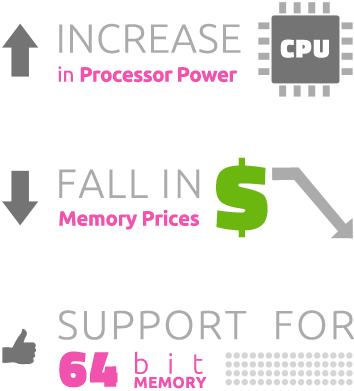The Solution: A Unified System of Record and Decision
Bringing together systems of record and systems of decision means that as business processes execute, business managers can make decisions based on the current state of the business and can bring in a range of supporting facts that can make those decisions stronger. This requires that transactional and analytical data be managed together. It also means that queries, reports, and visualizations for decisions makers must be generated not in days or hours but in seconds. It means that the system must support large amounts of supporting facts and be able to bring those facts to bear immediately upon demand.
The obvious solution to the problems associated with running separate transactional and analytical databases is to merge them into a single database environment. This has not been technically feasible — until now.
The reason this problem can be solved now is that,
because of the dramatic increase in processor power, fall in memory prices, and commonplace support for 64-bit memory systems, the relational database management system (RDBMS) world is moving rapidly toward memory-based databases. Such databases treat main memory, rather than disk, as the home for the data they manage. Some memory-based databases swap the data to compressed disk spaces, but others manage the data entirely in memory.


In-memory databases (IMDBs) offer key advantages over disk-based RDBMSs. For one thing, they are much faster. They are also more flexible, handling schema changes in minutes, whereas disk-based systems require days and sometimes weeks to make such changes because the data needs to be restructured on disk. This is important because businesses frequently need to make changes to the kinds of data they process and analyze but are usually constrained by their databases’ inability to support such changes in a timely manner.
When IDC surveyed 352 business managers about which of the benefits associated with a unified data management platform were the most significant for their organization or business unit, their responses were revealing (see Figure 3). Note that the three top benefits illustrated in the pie chart have to do with speed and accuracy, which are associated not only with a unified data platform, but also with in-memory data management.


